Table of Contents
- Introduction
- Editor’s Choice
- Virtual Events Market Overview and Statistics
- Tools Utilized to Carry Out Virtual Events Statistics
- Annual Frequency of Virtual Events Hosted by B2B Marketers
- Top Industries That Are Utilizing Live Video Streaming
- Preferred Formats for Hosting Virtual Business Events Statistics
- Key Reasons for Considering Virtual Events in Business Planning
- Attendee Expectations from Virtual Events Statistics
- Cost of Virtual Events
- Duration of Virtual Events
- Most Popular Virtual Event Platforms Among B2B Marketers
- Numerous Popular Virtual Events Types Statistics
- Most Common Ways to Engage Audience in Virtual Events
- Impact of COVID-19 on Virtual Events Statistics
- Main Advantages of Shifting from Physical to Virtual Events
- Top Virtual Event Hosting Challenges Statistics
- Recent Developments
- Conclusion
- FAQs
Introduction
Virtual Events Statistics: Virtual events are online gatherings that allow people and organizations to interact without physical presence, using digital platforms that support video streaming and interactive tools like chats and polls.
These events range from webinars and virtual conferences to live streams and trade shows. Key benefits include global reach, cost-effectiveness, and detailed participant analytics.
However, challenges such as technology reliability, maintaining engagement, and ensuring security are significant.
The future of virtual events looks towards hybrid formats that blend physical and virtual elements and innovative technologies like augmented reality (AR) and virtual reality (VR) to enhance interactivity and immersion.
This makes virtual events a versatile and increasingly popular option for connecting and learning in a digital-first world.
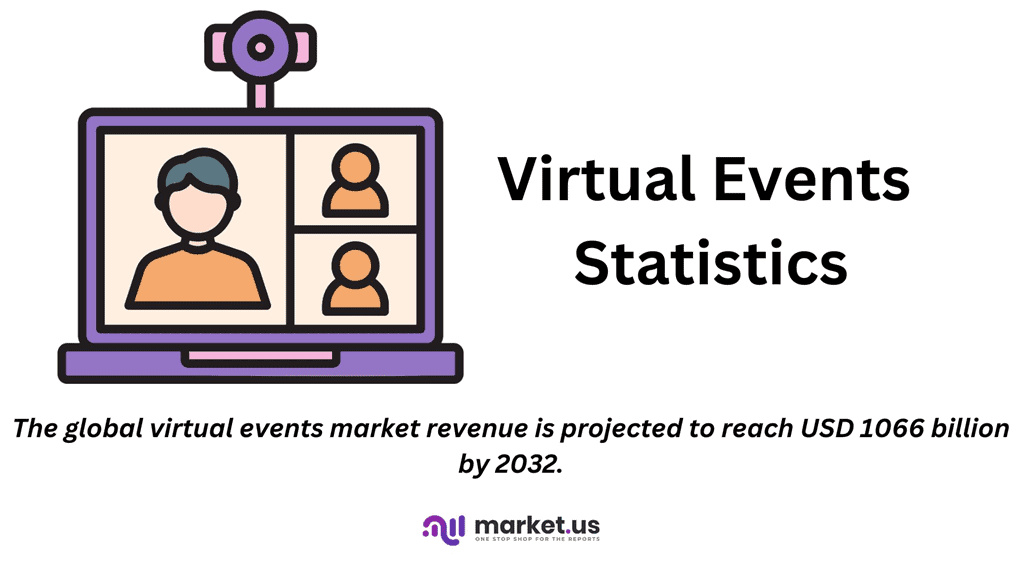
Editor’s Choice
- The global virtual events market revenue is projected to reach USD 1066 billion by 2032.
- North America leads with a substantial 38.4% share, reflecting its robust digital infrastructure and high adoption of virtual technologies.
- Microsoft Corporation leads with an 18% share, capitalizing on its comprehensive suite of collaboration tools.
- Regarding the tools employed for virtual events, an overwhelming 99% of polled companies acknowledged webinars as a crucial aspect of their marketing strategy.
- According to a survey of B2B marketers worldwide, as of May 2020, the largest share, 49%, reported hosting between 20 to 30 virtual events annually, indicating this as the most common frequency for engaging audiences.
- Live video streaming is increasingly being adopted across various industries, with broadcasters, operators, and media leading the charge, accounting for 30% of the usage.
- One-third find virtual events engaging, while only 23% perceive virtual conferences as truly distinctive.
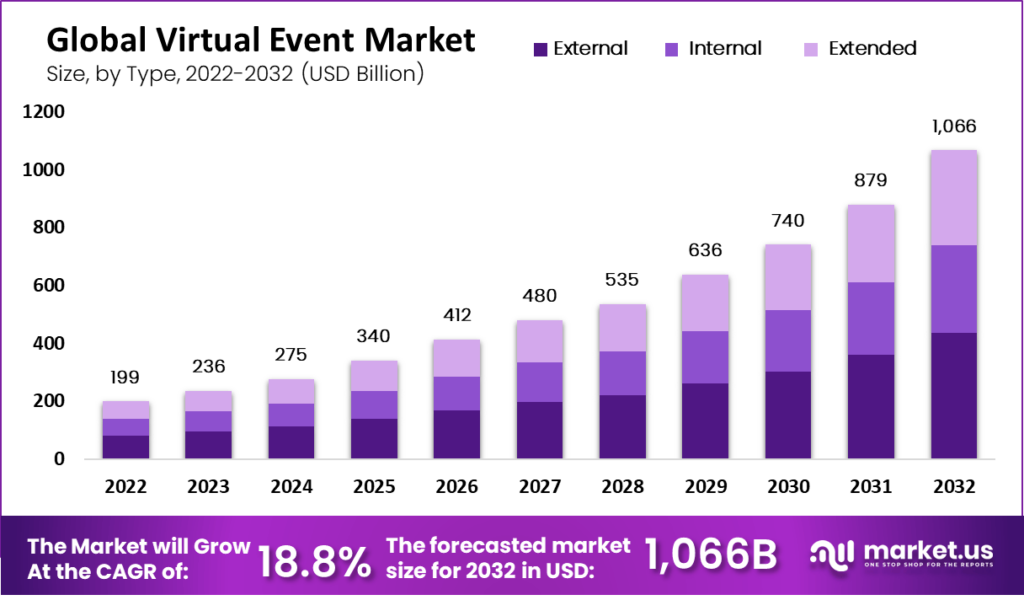
Virtual Events Market Overview and Statistics
Global Virtual Events Market Size Statistics
- The global virtual events market has demonstrated substantial growth in revenue from 2022 to 2032 at a CAGR of 18.8%.
- Starting at USD 199 billion in 2022, the market has projected increases each year, reaching USD 236 billion in 2023 and continuing its upward trajectory to USD 275 billion in 2024.
- The growth accelerates further, with the market expected to hit USD 340 billion by 2025, USD 412 billion by 2026, and USD 480 billion by 2027.
- By 2028, revenue is forecasted to reach USD 535 billion, escalating sharply to USD 636 billion in 2029 and then to USD 740 billion in 2030.
- The momentum continues as the market is anticipated to surge to USD 879 billion in 2031 and finally achieve a remarkable USD 1066 billion by 2032.
- This sustained increase underscores the expanding significance and adoption of virtual events globally.
(Source: Market.us)
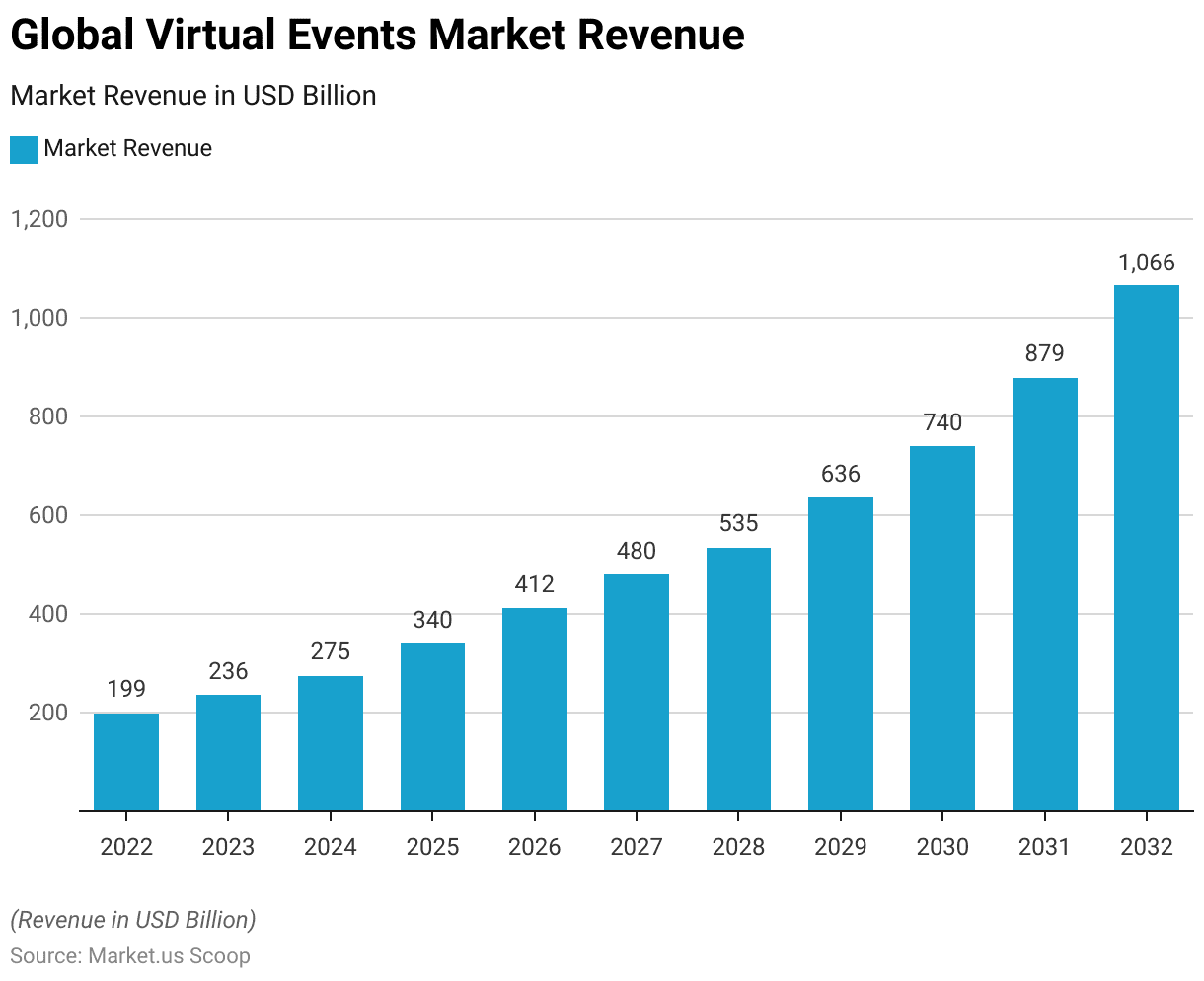
Global Virtual Events Market Share – By Region Statistics
- The distribution of the global virtual events market by region shows varying degrees of market share.
- North America leads with a substantial 38.4% share, reflecting its robust digital infrastructure and high adoption of virtual technologies.
- Following is the Asia-Pacific (APAC) region, holding a significant 26.8% of the market, driven by rapid technological advancements and increasing digitalization.
- Europe contributes 18.6% to the market share, supported by widespread technology use across both corporate and public sectors.
- The Middle East and Africa (MEA) and Latin America are smaller contributors, with 9.3% and 6.9% of the market, respectively, indicating growing opportunities and expanding digital adoption in these regions.
- This geographical segmentation highlights the global reach and varying growth dynamics of the virtual events industry.
(Source: Market.us)
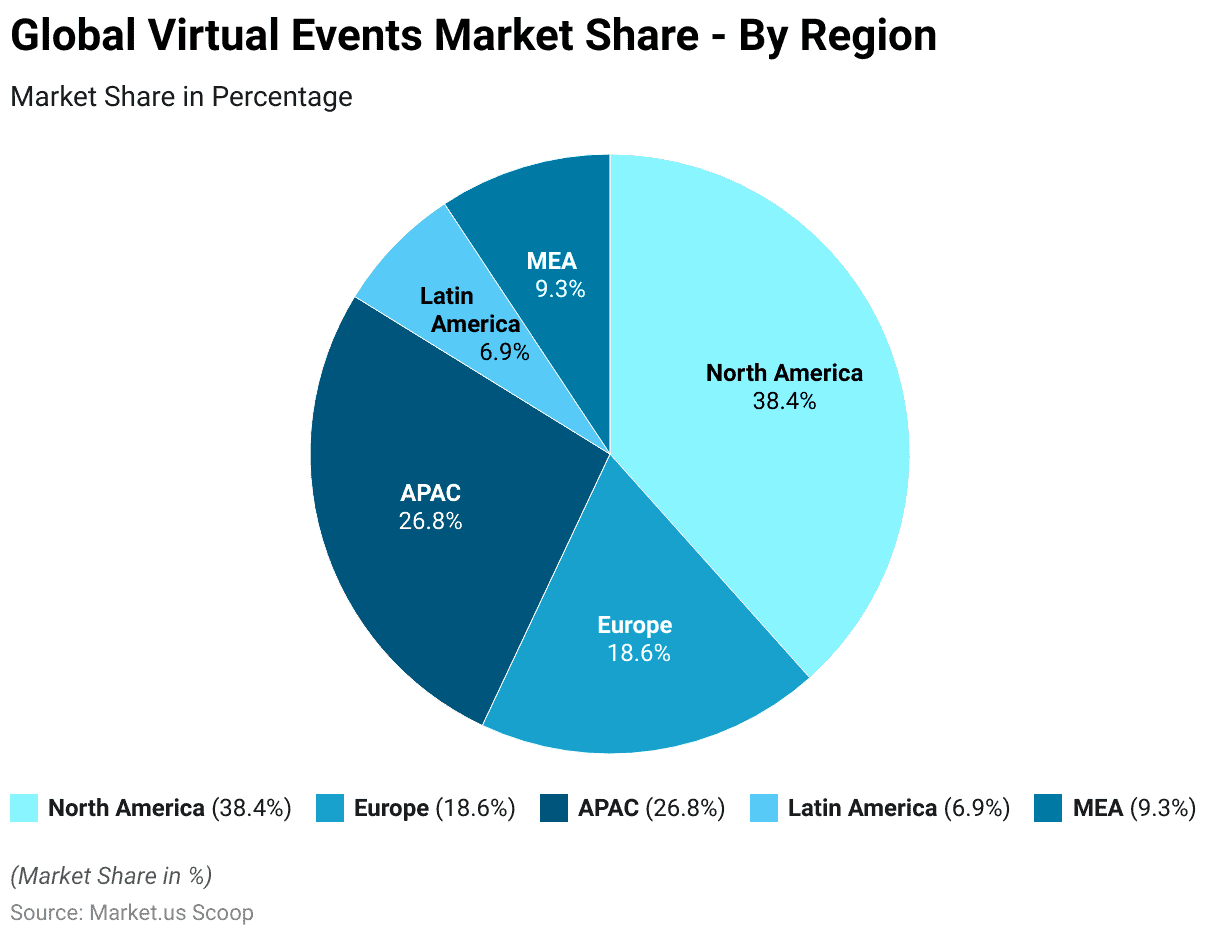
Competitive Landscape of the Global Virtual Events Market Statistics
- The market share distribution among companies in the global virtual events sector reveals a competitive landscape.
- Microsoft Corporation leads with an 18% share, capitalizing on its comprehensive suite of collaboration tools.
- Zoom follows with 14%, and it is known for its user-friendly video conferencing solutions.
- Both 6Connex and vFairs claim a 12% share each, reflecting their specialized offerings in virtual event platforms.
- Cisco Systems, Inc. holds an 11% stake, leveraging its strong presence in network technology.
- Alcatel-Lucent Enterprise and Cvent Holding Corp. contribute 9% and 8% to the market, respectively, showcasing their niche in providing robust event management and networking solutions.
- On24, Inc. accounts for 7%, focusing on webinar and virtual event services.
- Additionally, 9% of the market is held by other key players, indicating a diverse and dynamic competitive environment within the virtual events industry.
(Source: Market.us)
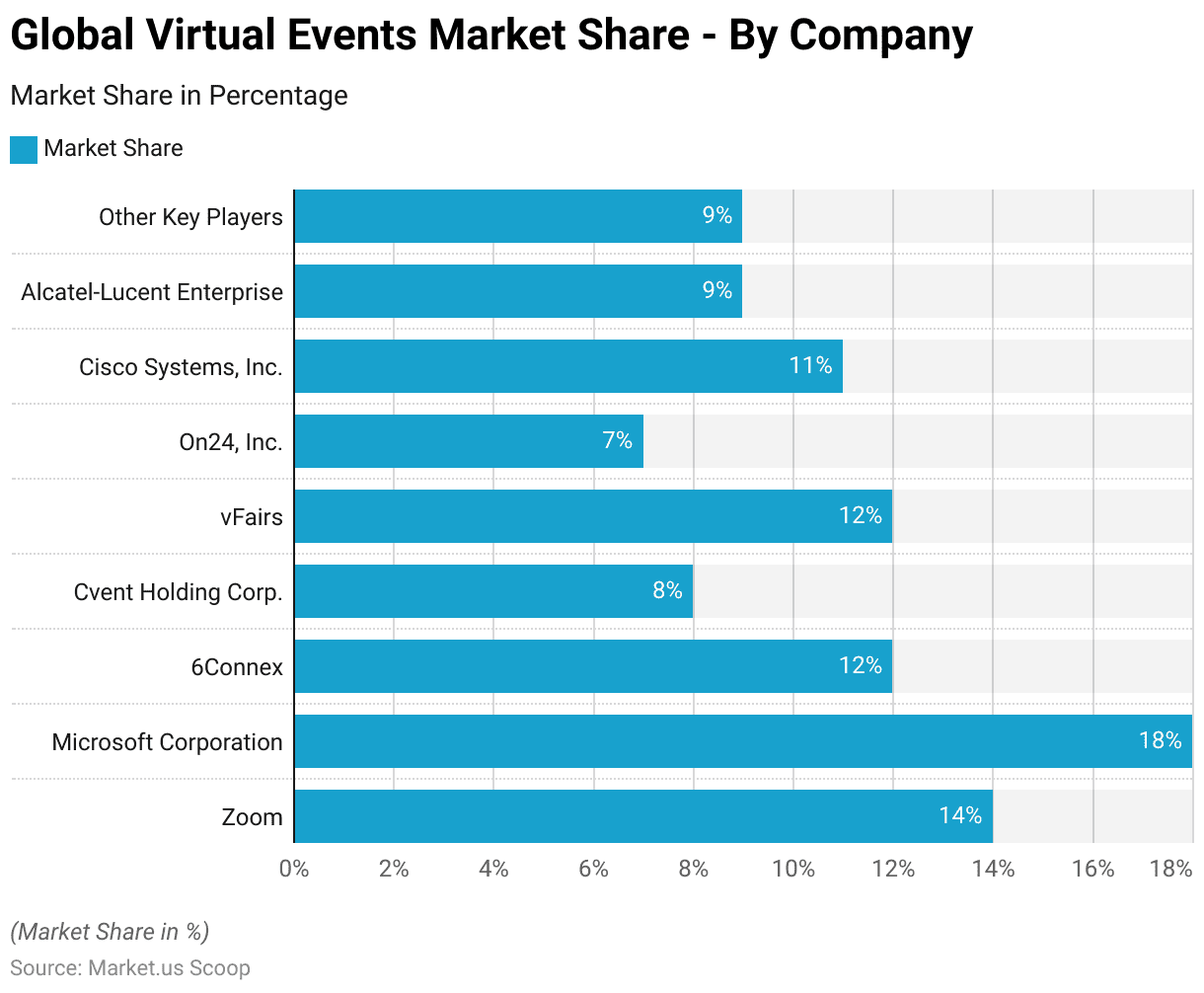
Tools Utilized to Carry Out Virtual Events Statistics
- Regarding the tools employed for virtual events, approximately half of the global event attendees favored webinars.
- This preference was corroborated by a survey in June 2021, where an overwhelming 99% of polled companies acknowledged webinars as a crucial aspect of their marketing strategy.
- Live meetings software was preferred by 43% of respondents, while over a third expressed a preference for a fully immersive event experience.
- Livestream video emerged as a popular digital engagement tactic, utilized by nearly three-quarters of global marketers as of June 2021, with an additional 20% planning to incorporate it.
- The surge in online experiences in 2020 led to intense competition among video-calling platforms for market dominance.
- Zoom emerged as the clear leader, being utilized by over half of the surveyed companies for teleconferences, while just over 10% opted for Microsoft Teams.
(Source: Statista)
Annual Frequency of Virtual Events Hosted by B2B Marketers
- According to a survey of B2B marketers worldwide as of May 2020, the number of virtual events hosted per year varies significantly among respondents.
- The largest share, 49%, reported hosting between 20 and 30 virtual events annually, indicating this as the most common frequency for engaging audiences.
- Eighteen percent of marketers are slightly less active, hosting between 15 to 20 events per year.
- Those hosting more than 30 events per year represent 21% of the respondents, reflecting a segment of highly active marketers.
- Meanwhile, a smaller group, 12% of respondents, reported hosting fewer than 15 events annually, suggesting a more selective approach to virtual event engagement.
- This distribution underscores the varying reliance on virtual events within the B2B marketing community.
(Source: Statista)
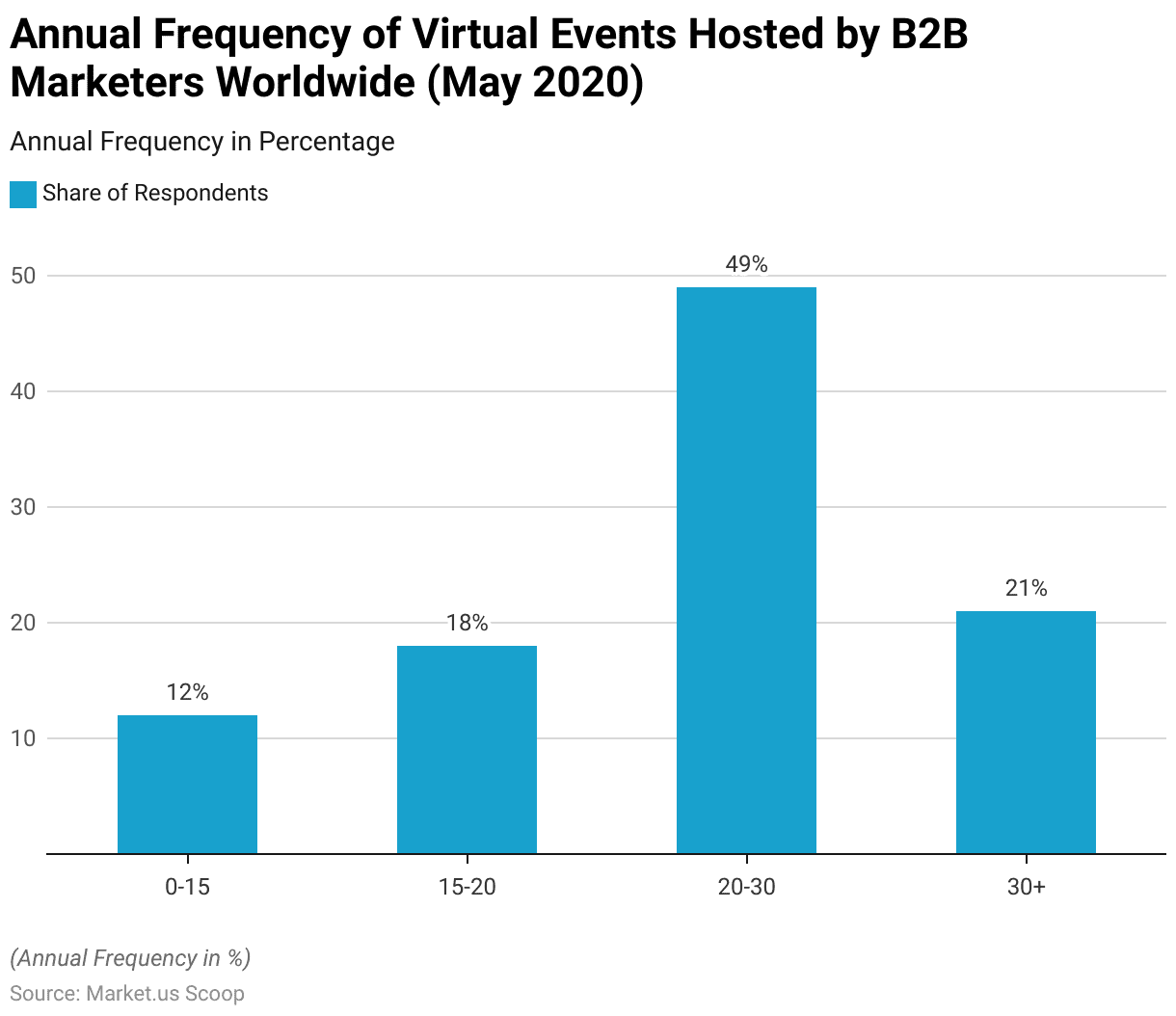
Top Industries That Are Utilizing Live Video Streaming
- Live video streaming is increasingly being adopted across various industries, with broadcasters, operators, and media leading the charge, accounting for 30% of the usage.
- The Banking, Finance, Security, and Insurance (BFSI) sector follows closely, utilizing live video streaming for 25% of their digital interactions.
- The education sector also significantly incorporates this technology, representing 20% of the usage, reflecting its growing importance for remote learning and online courses.
- Additionally, the remaining 25% is distributed among all other industries, indicating a broad and versatile application of live video streaming across diverse fields.
- This widespread adoption underscores the technology’s critical role in modern digital communication and content delivery strategies.
(Source: Mhojhos Research)
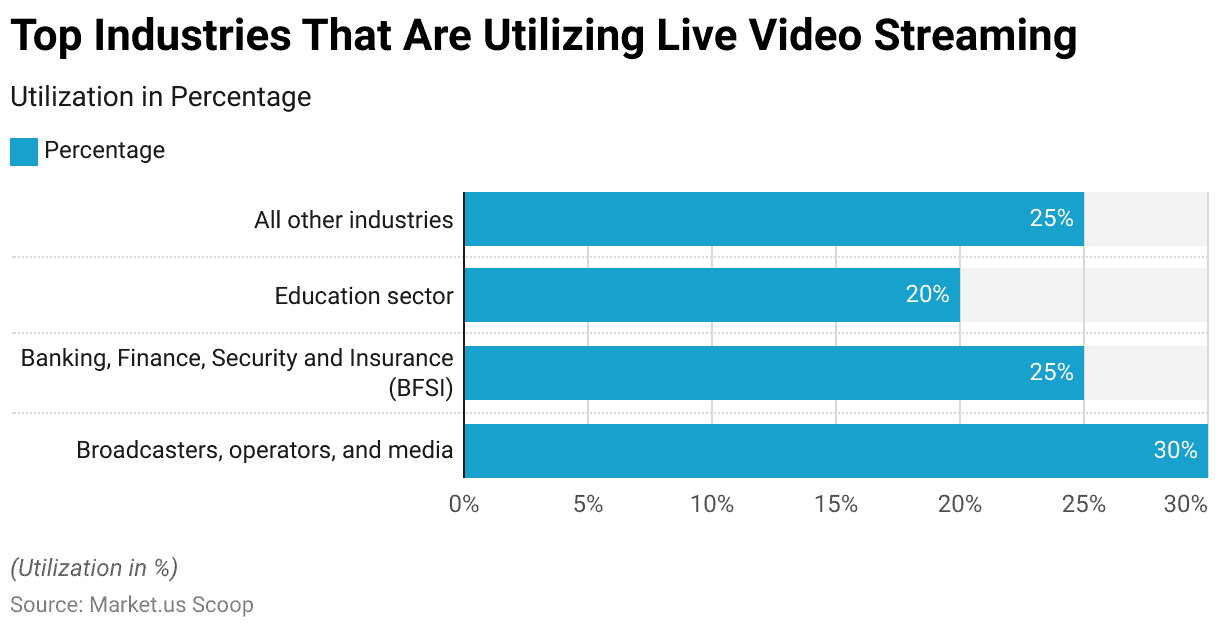
Preferred Formats for Hosting Virtual Business Events Statistics
- A poll on preferred formats for hosting business events in 2024 reveals a diverse landscape of choices among organizers.
- In-person events lead slightly, with 35% of respondents favoring this traditional format.
- Hybrid events, which combine in-person and virtual elements, are a close second, preferred by 34% of respondents.
- Virtual events are also popular, chosen by 29% of participants, highlighting the enduring impact of remote interaction technologies.
- Other, less conventional formats make up a small fraction, accounting for just 2% of preferences.
- This distribution underscores the evolving nature of business event planning, accommodating various attendee needs and technological capabilities.
(Source: LinkedIn)
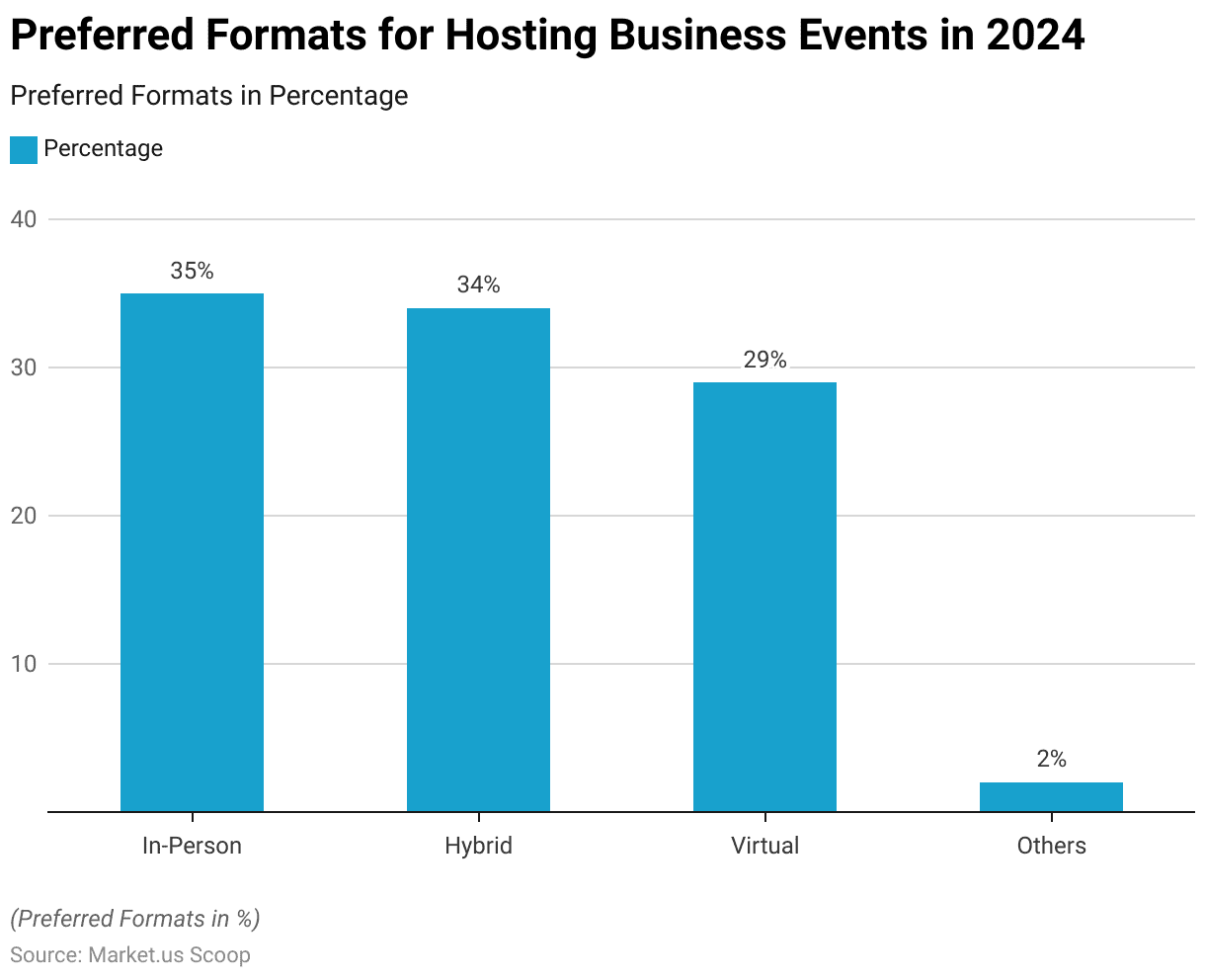
Key Reasons for Considering Virtual Events in Business Planning
- A survey highlighting the reasons businesses consider hosting virtual events shows a clear preference for certain advantages.
- A significant 77.2% of respondents cite the ease of attendance as a primary factor, demonstrating the value of convenience in increasing participation.
- Global reach is another major benefit, with 64.9% acknowledging the ability of virtual events to connect people across different geographical locations.
- Cost-effectiveness also plays a critical role, with 47.4% of those surveyed pointing to the low cost of virtual events as a deciding factor.
- Additionally, 14% of respondents recognize sponsorships as a main attraction, indicating that virtual events can also offer substantial opportunities for brand partnerships and exposure.
- This data underscores the diverse motivations behind the choice to host virtual events, reflecting their strategic importance in modern business practices.
(Source: LinkedIn)
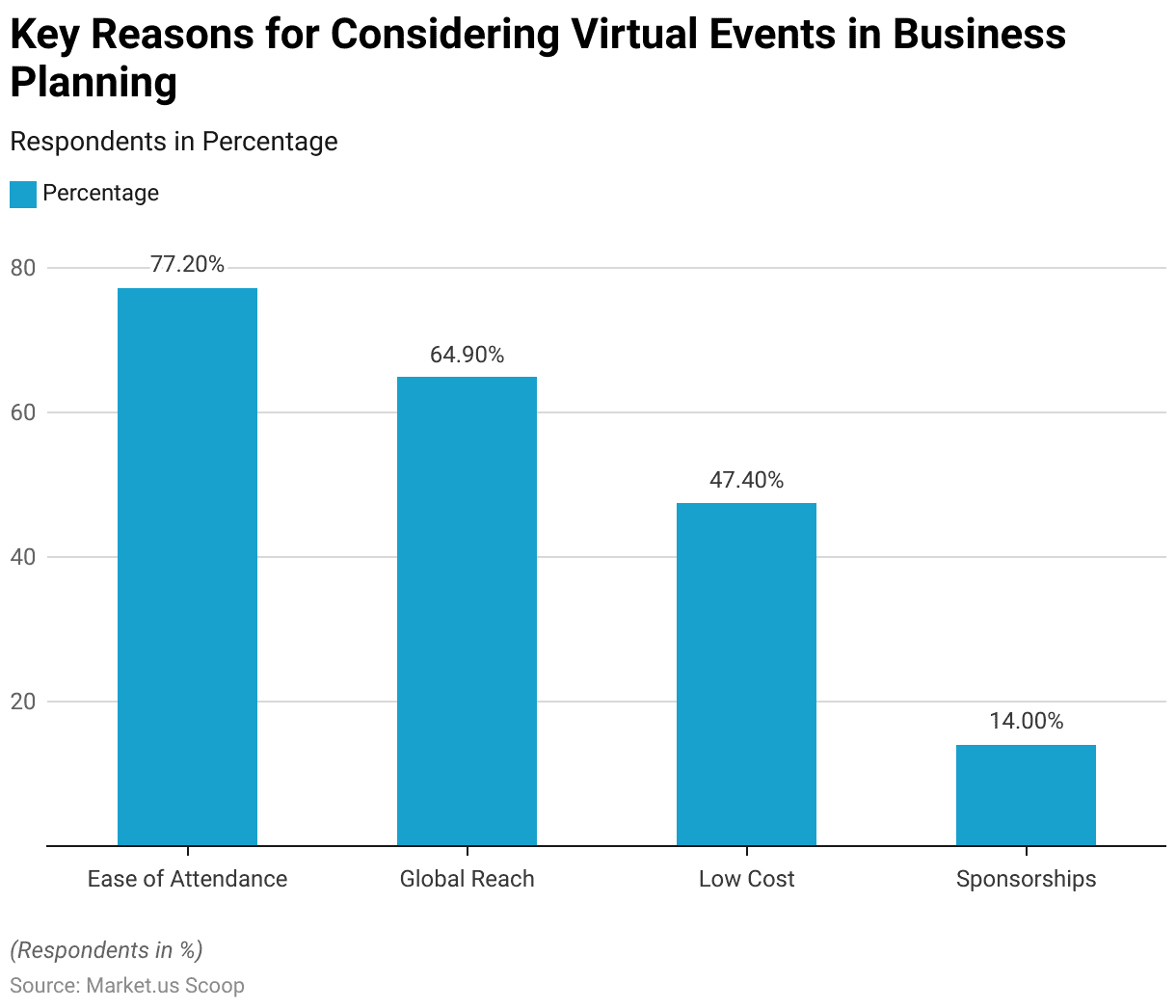
Attendee Expectations from Virtual Events Statistics
- Attendees of virtual events express various preferences and expectations, reflecting their desire for engaging and unique experiences.
- One-third find virtual events engaging, while only 23% perceive virtual conferences as truly distinctive.
- The interactive nature of Q&A sessions captures the attention of 78% of participants, and nearly 80% express interest in MasterClass-style courses.
- The importance of presenter enthusiasm is emphasized, with 67% agreeing that engaging and passionate speakers are essential.
- Additionally, the quality of speakers significantly influences 64% of attendees in their decision to attend virtual events.
- A vast majority, 84%, express a consistent desire to have the option to attend virtual events, highlighting their enduring appeal.
- Attendees also advocate for improvements, including more live-streamed keynotes and event content (58%), better online session access (45%), increased hybrid event offerings (38%), online commerce capabilities for continuous sales (29%), and enhanced educational access (28%).
- Overall, attendees seek more personalized, high-energy experiences to enhance their virtual event engagements.
(Source: Vimeo, RedBack Connect, Vimeo, Kaltura, The State of Virtual Events 2022, Emerald, B2B Events Industry Outlook 2022)
Cost of Virtual Events
- The average cost per attendee for virtual events varies significantly, as indicated by survey data.
- A notable proportion, 18%, falls within the range of $200 to $500, reflecting relatively budget-friendly options.
- However, a substantial 34% of virtual events have a cost per attendee ranging from $500 to $1000, indicating a higher level of investment in these experiences.
- Similarly, 31% of events are priced between $1000 to $1500 per attendee, suggesting a considerable expenditure for participation.
- For a smaller segment, representing 17% of virtual events, the cost per attendee exceeds $1500, signaling premium offerings or specialized experiences that command a higher price point.
- This distribution underscores the diverse pricing strategies employed within the virtual events industry to cater to different budgets and expectations.
(Source: Markletic)
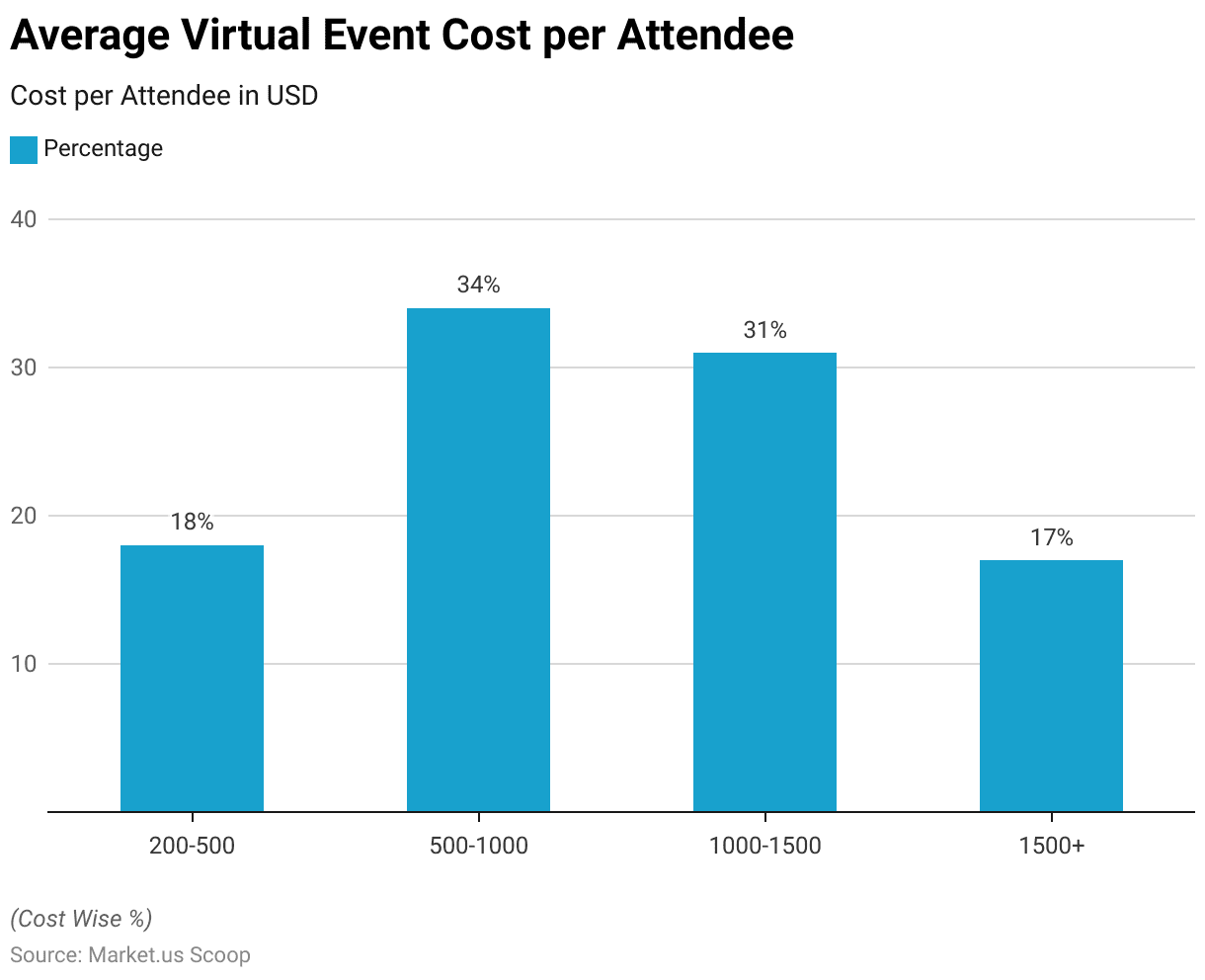
Duration of Virtual Events
- The duration of virtual events varies widely, as evidenced by survey findings.
- A majority, comprising 57%, are single-day events, suggesting a preference for concise and focused gatherings among organizers and attendees alike.
- Meanwhile, two-day events account for 14% of the total, offering a slightly extended timeframe for more comprehensive programming and engagement opportunities.
- Three-day events constitute 9% of virtual gatherings, providing further flexibility for content delivery and participant interaction.
- A smaller percentage, 3%, extends to four-day events, catering to specialized topics or extensive agendas.
- Events spanning five to nine days capture 6% of the market, accommodating in-depth exploration of complex subjects or multi-faceted agendas.
- Notably, 11% of virtual events are ten days or longer, indicating a commitment to extensive content delivery or immersive experiences over an extended period.
- This diverse array of durations reflects the flexibility and adaptability of virtual event formats to meet the diverse needs and preferences of organizers and attendees.
(Source: Bizzabo)
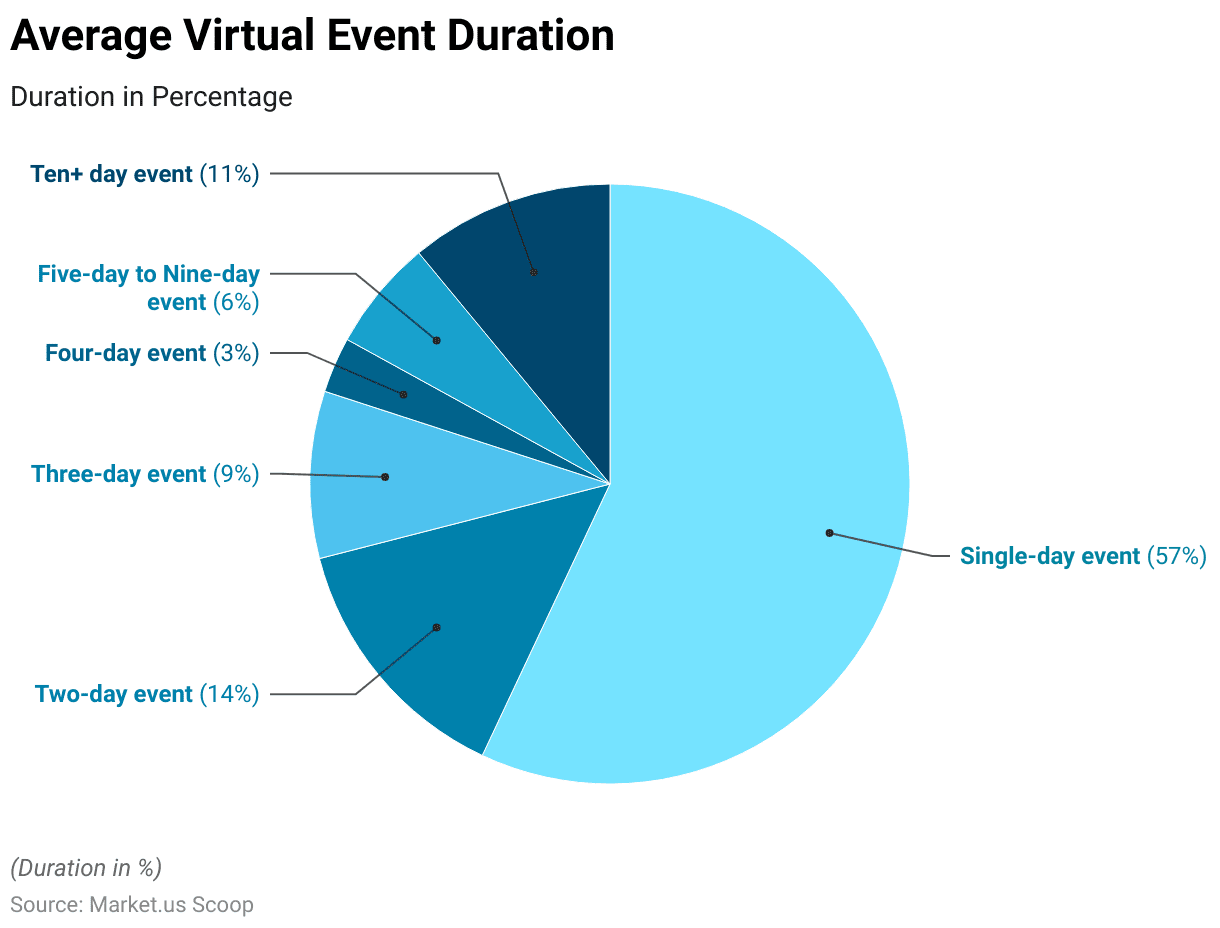
Most Popular Virtual Event Platforms Among B2B Marketers
- Among B2B marketers, several virtual event platforms stand out as particularly popular choices.
- Intrado leads the pack with a significant market share of 31.60%, indicating its widespread adoption and trusted reputation among businesses.
- ON24 follows closely behind, capturing 20.10% of the market, showcasing its robust features and capabilities for hosting engaging virtual events.
- Bizzabo and Intellum both hold notable shares, with 14.80% and 14.40%, respectively, highlighting their appeal to organizations seeking versatile and customizable event solutions.
- Kaltura, with a 10.10% share, and Hopin, with 9%, round out the list, offering competitive platforms with unique features tailored to the needs of B2B marketers.
- This distribution reflects the diverse options available in the virtual event platform market, catering to the specific requirements and preferences of businesses seeking to host impactful online events.
(Source: Markletic)
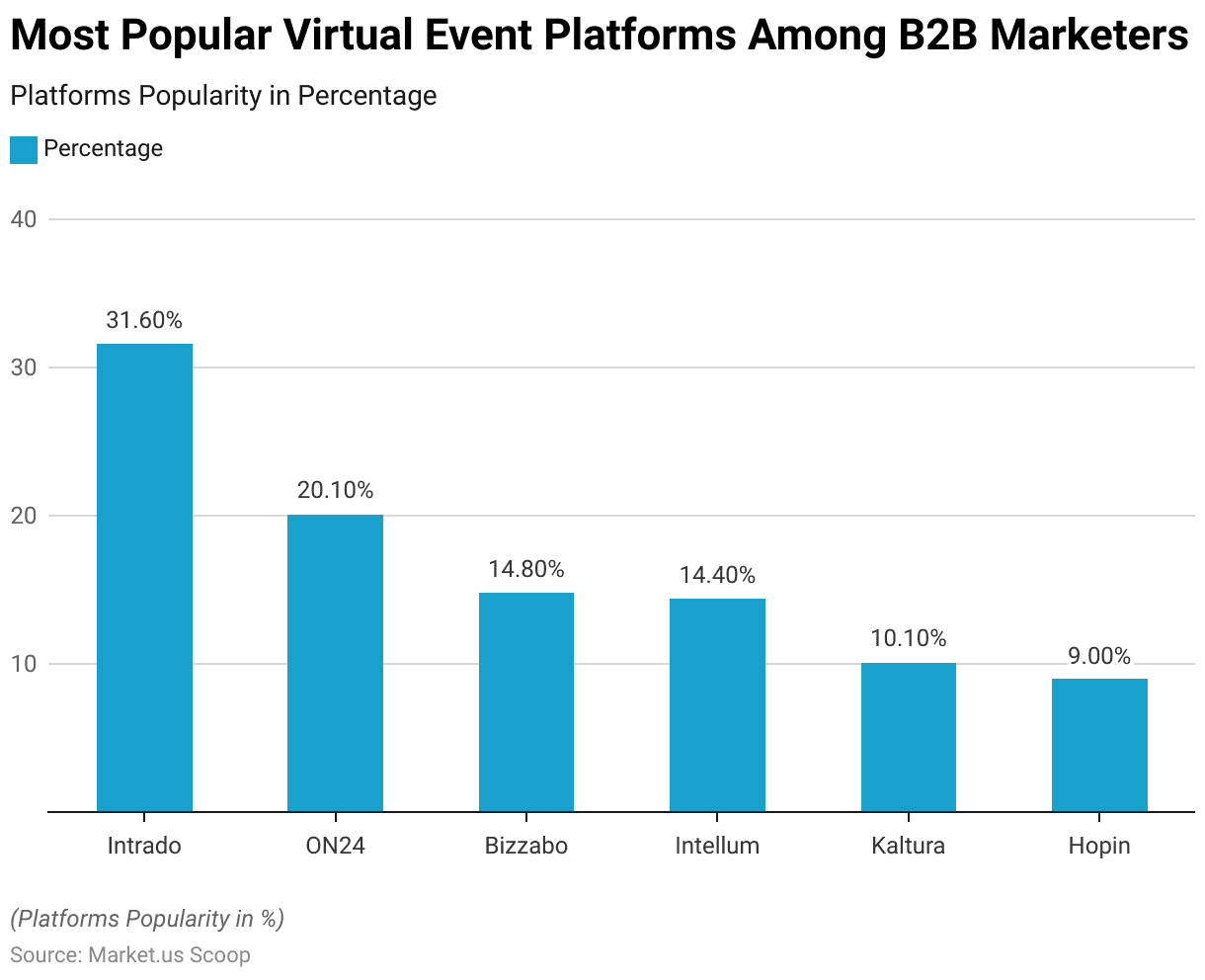
Numerous Popular Virtual Events Types Statistics
- On Bizzabo, a leading virtual event platform, various event types are prominently featured, catering to diverse organizational needs and objectives.
- The most popular event type is conferences and conventions, constituting a substantial 43% of virtual events hosted on the platform.
- Following closely behind are meetings and networking events, accounting for 23% of Bizzabo’s virtual gatherings, highlighting the platform’s efficacy in facilitating professional connections and interactions.
- Internal events, such as team meetings and company-wide gatherings, comprise 13% of the total, reflecting Bizzabo’s versatility in supporting internal organizational functions.
- Additionally, classes and workshops, trade shows and expos, social gatherings, and launch events each contribute smaller percentages, ranging from 7% to 2%, showcasing the platform’s ability to accommodate various event formats and purposes.
- Webinars, recruiting events, fundraisers, and galas also make appearances, albeit with smaller shares, underscoring Bizzabo’s comprehensive offerings for different event categories.
- This diversity of event types on Bizzabo underscores its suitability for a wide range of virtual gatherings, making it a popular choice among event organizers seeking effective and customizable solutions.
(Source: Bizzabo)
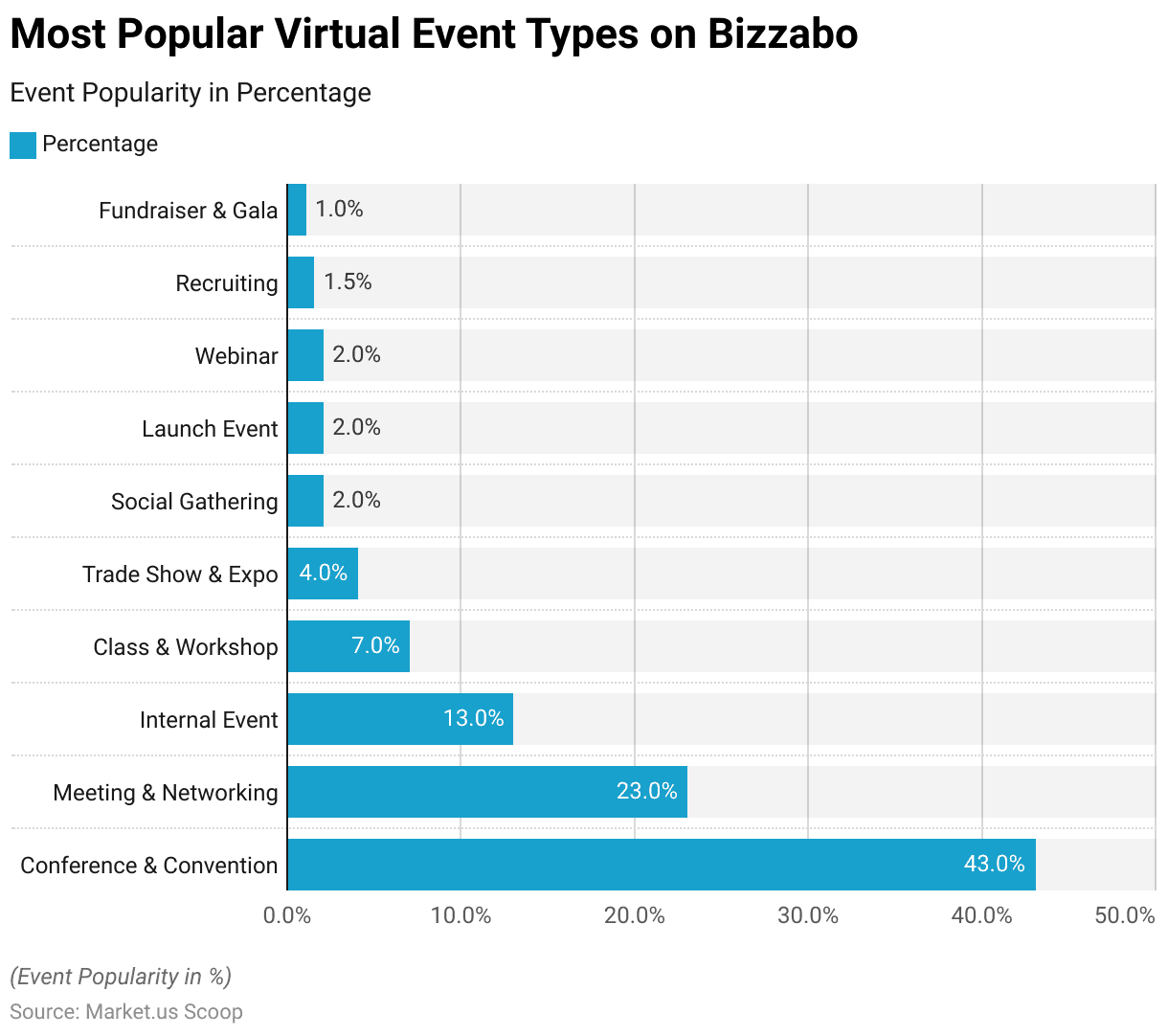
Most Common Ways to Engage Audience in Virtual Events
- In virtual events, engaging the audience is essential for ensuring active participation and a memorable experience.
- Polling emerges as the most common method utilized by 71% of organizers to solicit feedback, gather opinions, and encourage interactivity among attendees.
- Videos are also highly effective, with 61% of organizers incorporating them to convey information, tell stories, and captivate the audience visually.
- Short presentations are another popular tactic adopted by 56% of organizers to deliver focused content and maintain audience attention.
- Multiple speakers contribute to diversity and depth in discussions, with 45% of organizers leveraging them to provide varied perspectives and expertise.
- Furthermore, gamification strategies, such as quizzes and challenges, are employed by 30% of organizers to add an element of fun and competition, fostering engagement and participation.
- These common methods collectively enhance the virtual event experience, facilitating meaningful interaction and connection between hosts and attendees.
(Source: Eventtus)
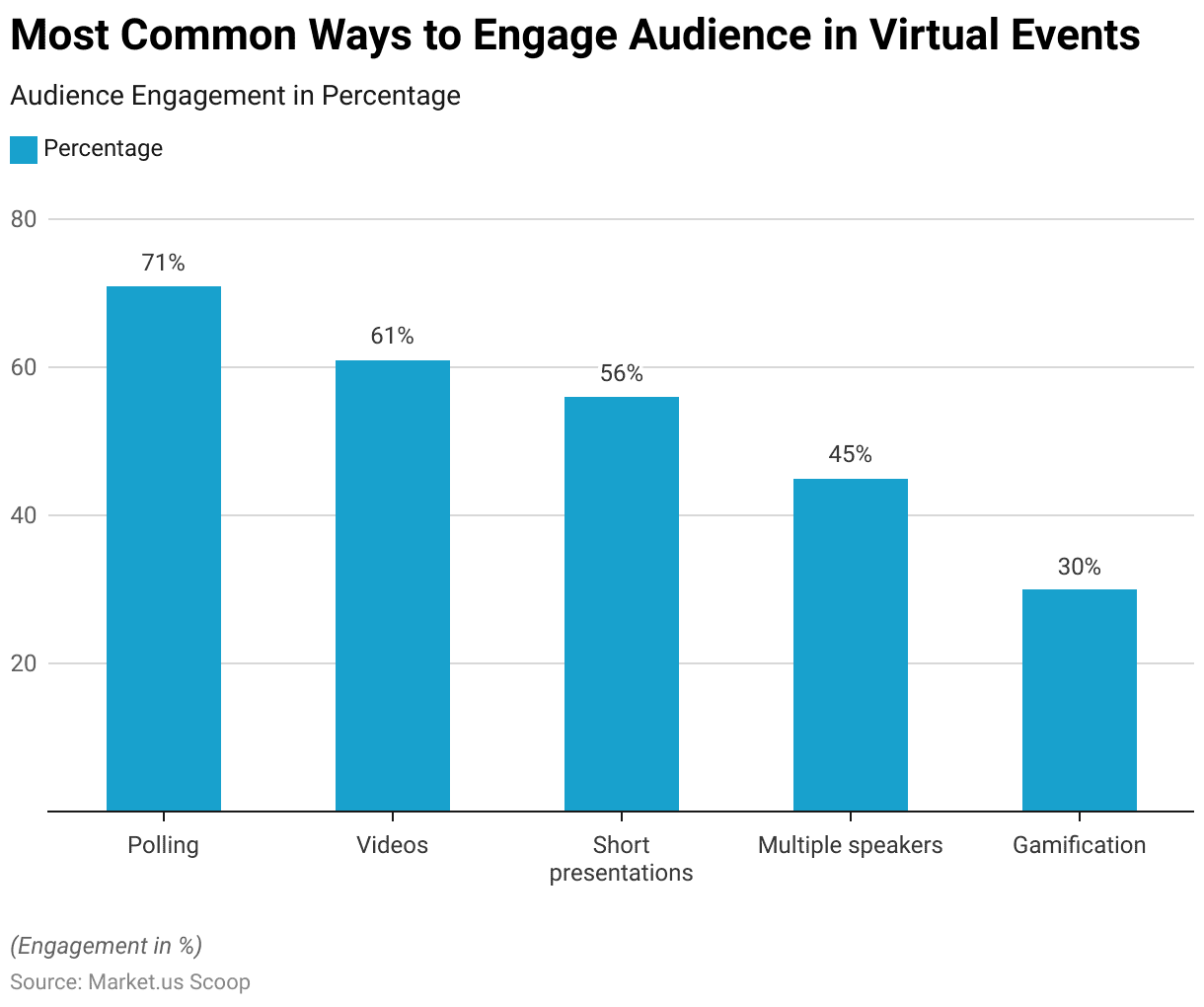
Impact of COVID-19 on Virtual Events Statistics
- In March 2021, a survey revealed varying preferences for attending events post-coronavirus (COVID-19) pandemic across different countries.
- In the United Kingdom, a majority of 56% preferred exclusively in-person meetings, with 39% opting for a hybrid of in-person and virtual means and a minimal 5% choosing only video conferencing.
- Similarly, Germany showed a strong preference for in-person engagements at 55%, with 43% favoring both formats and a mere 2% exclusively using video conferencing.
- Australia and France also demonstrated a greater inclination towards in-person meetings at 52% and 51%, respectively, with both countries showing a significant 43% support for hybrid meetings.
- Conversely, in the United States, only 42% preferred in-person meetings, while a majority of 52% were amenable to using both in-person and virtual methods, and 6% adhered strictly to video conferencing.
- Brazil and Singapore recorded the lowest percentages for in-person-only meetings at 38% but showed a higher acceptance of hybrid meeting formats at 59% and 55%, respectively.
- India and Japan presented a notable divergence from other nations, with a stronger preference for hybrid and virtual models. In India, 37% still favored in-person meetings, but a significant 53% were open to both formats, and 10% chose only video conferencing—the highest among surveyed countries.
- Japan had the lowest preference for exclusively in-person meetings at 31% but the highest for hybrid formats at 65%, alongside 5% preferring only video conferencing.
- These variations highlight distinct cultural and possibly infrastructural differences influencing the adoption of virtual communication post-pandemic.
(Source: Statista)
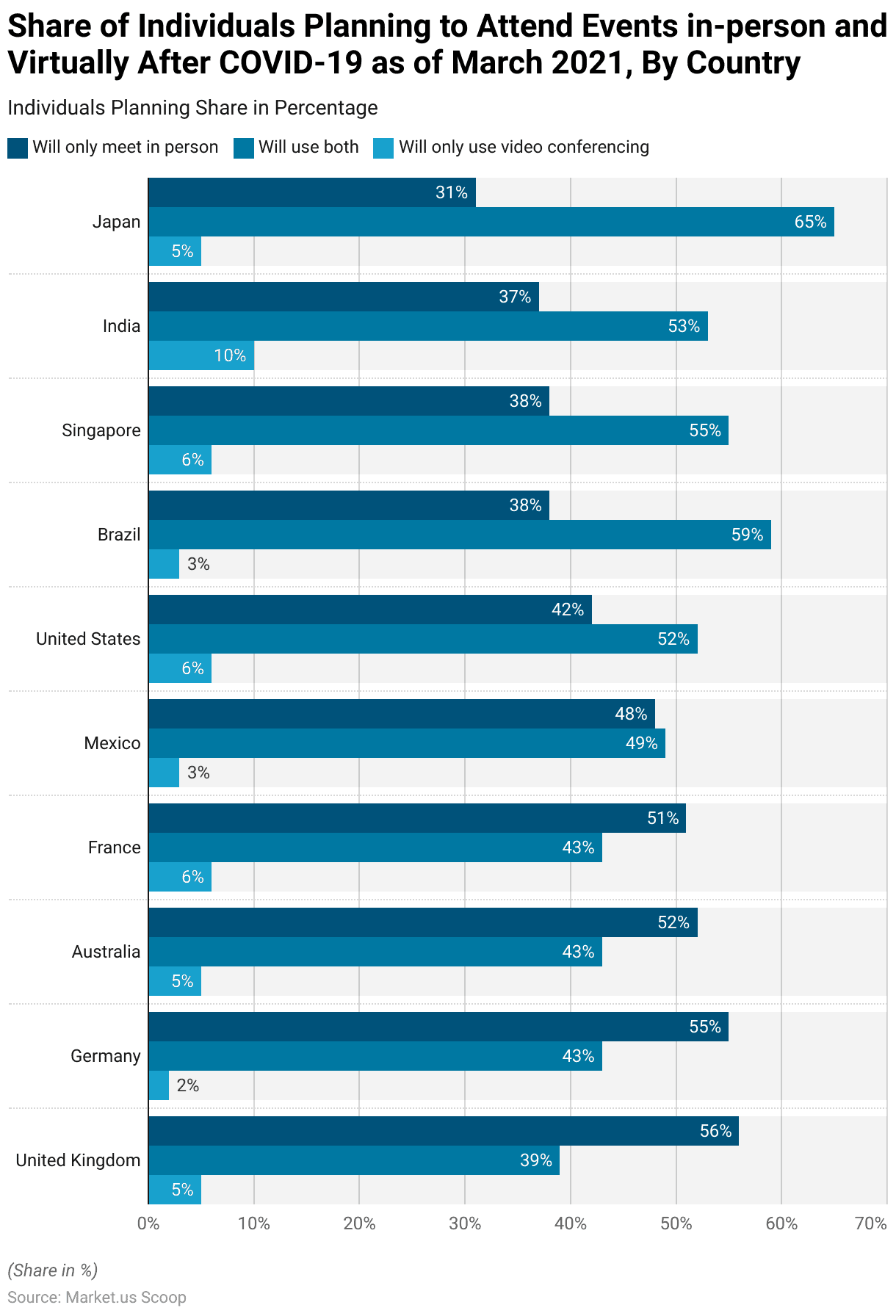
Main Advantages of Shifting from Physical to Virtual Events
- Shifting from physical to virtual events offers several significant advantages for organizers and participants alike.
- Foremost among these is the potential for increased attendance and reach, as noted by 49.30% of respondents. Virtual events eliminate geographical barriers, allowing individuals from diverse locations to participate, thus expanding the event’s audience and impact.
- Additionally, the transition to virtual platforms often results in significantly lower overhead costs, a benefit acknowledged by 14.90% of respondents. This reduction in expenses can encompass venue rental fees, travel and accommodation costs, and logistical expenses, leading to overall cost savings for event organizers.
- Furthermore, 11.10% of respondents highlight the discovery of new viable revenue sources as a key advantage. Virtual events open up opportunities for monetization through sponsorship, ticket sales, and digital content offerings.
- Long-term community engagement is also cited as a benefit by 8.50% of respondents, as virtual events provide ongoing opportunities for interaction and connection beyond the confines of a physical gathering.
- While challenges exist, such as adapting to new technologies and formats, the advantages of shifting to virtual events offer compelling reasons for organizers to embrace this evolving trend in event planning.
(Source: EventMB)
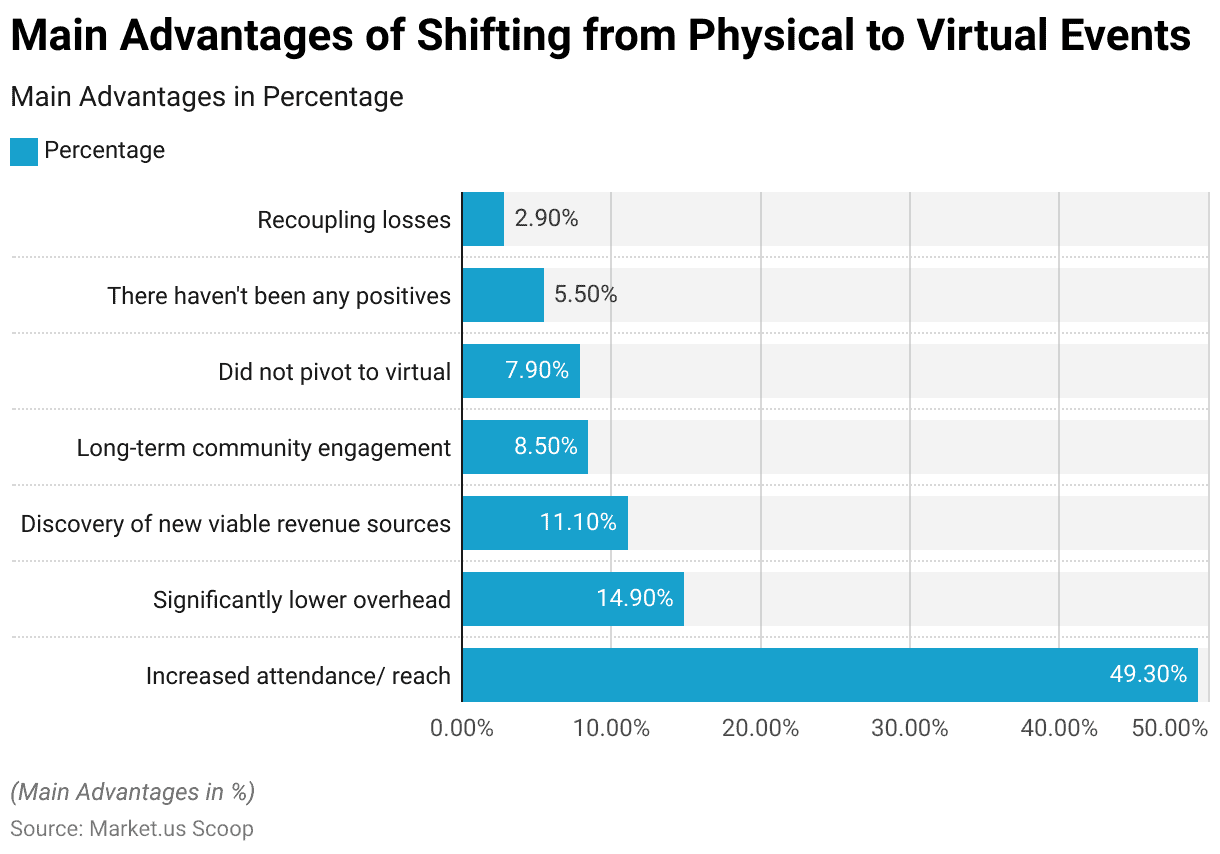
Top Virtual Event Hosting Challenges Statistics
- Hosting virtual events presents a unique set of challenges compared to in-person gatherings, as reported by event organizers.
- Networking emerges as the most prominent challenge, cited by 68.80% of respondents, indicating the difficulty in facilitating meaningful connections and interactions in a virtual environment.
- Engagement closely follows, with 67.70% of organizers expressing concerns about maintaining audience interest and participation throughout the event.
- Differentiation poses another significant hurdle, with 52.90% of respondents grappling with the task of making their virtual event stand out amidst a crowded landscape of online offerings.
- Logistics, including technical setup and event execution, are also cited as a challenge by 52.50% of organizers, highlighting the complexity of coordinating virtual experiences.
- Additionally, securing sponsors proves to be a concern for 36.90% of respondents, as virtual events may offer fewer opportunities for sponsor visibility and engagement compared to traditional in-person events.
- Lastly, maintaining the impact and effectiveness of the event is a challenge for 35.70% of organizers, underscoring the importance of carefully planning and executing virtual events to achieve desired outcomes and objectives.
- Addressing these challenges requires innovative strategies and technological solutions to enhance the overall success of virtual event hosting.
(Source: Bizzabo)
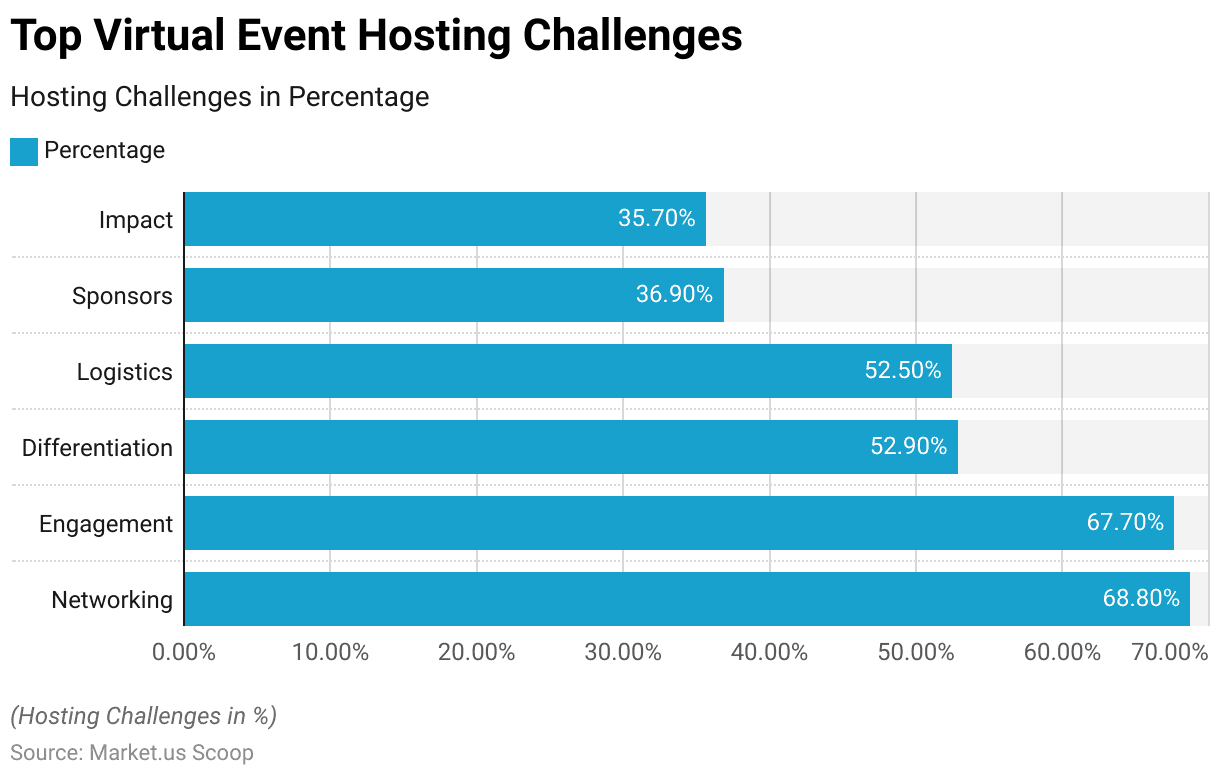
Recent Developments
Acquisition:
- Zoom’s Acquisition of Five9: Zoom, a leading provider of video conferencing solutions, announced its acquisition of Five9, a cloud-based contact center software company.
- The acquisition, valued at $14.7 billion, signifies Zoom’s strategic expansion into the customer service and virtual events market.
- By integrating Five9’s capabilities with its platform, Zoom aims to offer enhanced virtual event solutions and customer engagement tools.
- In August 2022, Zoom acquired Liminal, which includes the integration of Liminal’s virtual event tools, ZoomOSC and ZoomISO, into Zoom’s platform. This acquisition aims to enhance professional virtual event capabilities.
Product Launches:
- In May 2023, the Indian tech startup VOSMOS launched VOSMOS.Event is a platform allowing the organization of virtual events to vary greatly in scale, providing tools for dynamic and secure event hosting.
- Zoom also introduced ‘Zoom Events’ in India in October 2022, which includes features to enhance online event experiences and maximize ROI.
- Hopin’s Launch of Hopin Studios: Hopin, a popular virtual events platform, introduced Hopin Studios, a new feature designed to elevate the production quality of virtual events.
- Hopin Studios provides event organizers with access to professional-grade production services, including virtual stage design, live streaming, and interactive engagement tools.
- The launch of Hopin Studios aims to address the growing demand for high-quality and engaging virtual event experiences.
Fundings:
- Remo’s Series B Funding Round: Remo, a virtual event platform focused on facilitating networking and social interactions, raised $50 million in its Series B funding round led by Tiger Global Management.
- The funding will support Remo’s product development efforts and global expansion initiatives. As virtual events continue to gain momentum, Remo aims to capitalize on the growing market demand for immersive and interactive event experiences.
Innovations and Technology Integration:
- There is a significant emphasis on incorporating augmented reality (AR) and virtual reality (VR) into virtual events to enhance interactivity and engagement.
- Event platforms are increasingly using AI to facilitate better networking and personalized experiences during virtual events.
Sector-Specific Developments:
- The communication segment has seen the most significant revenue growth due to the widespread adoption of virtual meetings and conferences.
- The education and corporate sectors are increasingly utilizing virtual event platforms for training, meetings, and collaborative activities.
Conclusion
Virtual Events Statistics – In conclusion, virtual events have become essential in modern communication and engagement, particularly in response to the COVID-19 pandemic.
Offering benefits like accessibility, cost-effectiveness, and global reach, they facilitate meaningful interactions and knowledge sharing through various formats like webinars and conferences.
While challenges such as attendee engagement and technical logistics persist, ongoing technological advancements drive their evolution.
Virtual events are poised to remain crucial tools for organizations looking to connect with audiences, adapt to changing landscapes, and achieve strategic objectives in an increasingly interconnected world.
FAQs
Virtual events are gatherings that take place online rather than in person, leveraging digital platforms to facilitate interactions, presentations, and networking.
Virtual events can range from webinars and conferences to trade shows, networking sessions, product launches, and more, catering to various purposes and audiences.
Virtual events offer increased accessibility, cost savings, global reach, flexibility, and the ability to track attendee engagement and gather data insights.
It depends on the event. Some virtual events may be free to attend, while others may require registration fees or ticket purchases, particularly for larger conferences or premium content.
Hybrid events combine elements of both in-person and virtual gatherings, allowing attendees to participate either physically or online. This format offers the benefits of both worlds, accommodating different preferences and circumstances.
Discuss your needs with our analyst
Please share your requirements with more details so our analyst can check if they can solve your problem(s)



